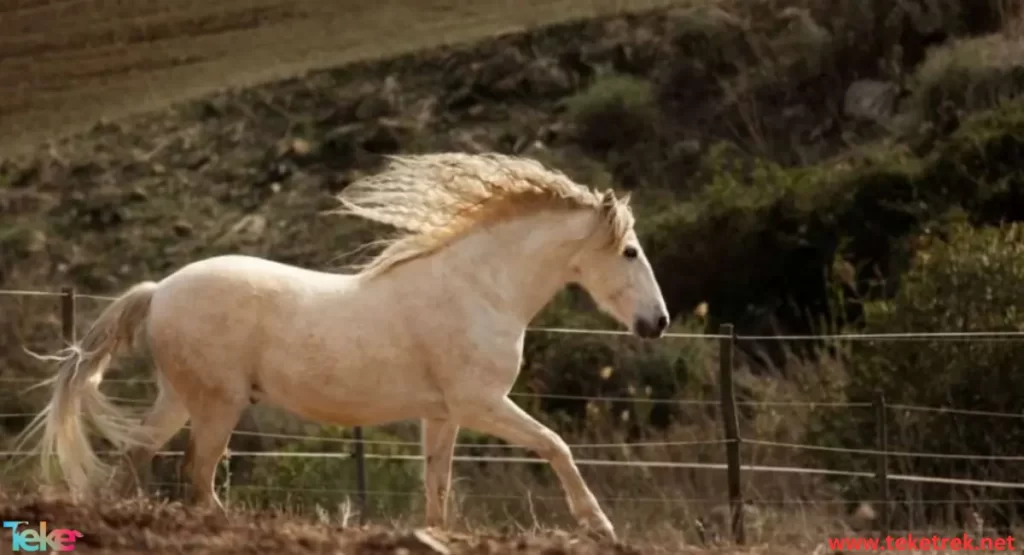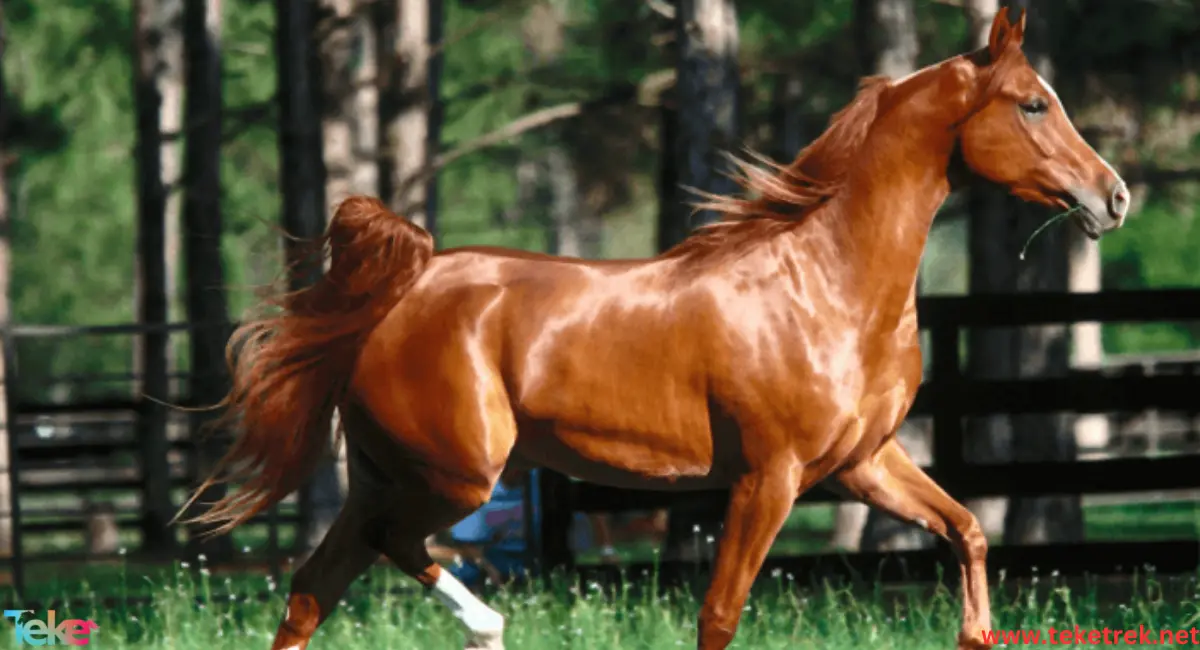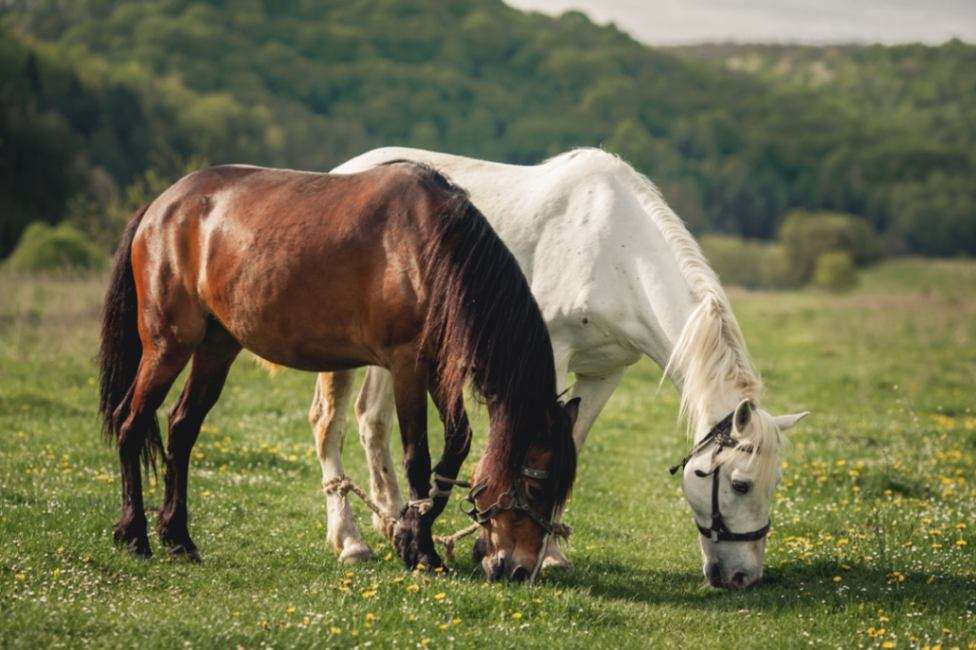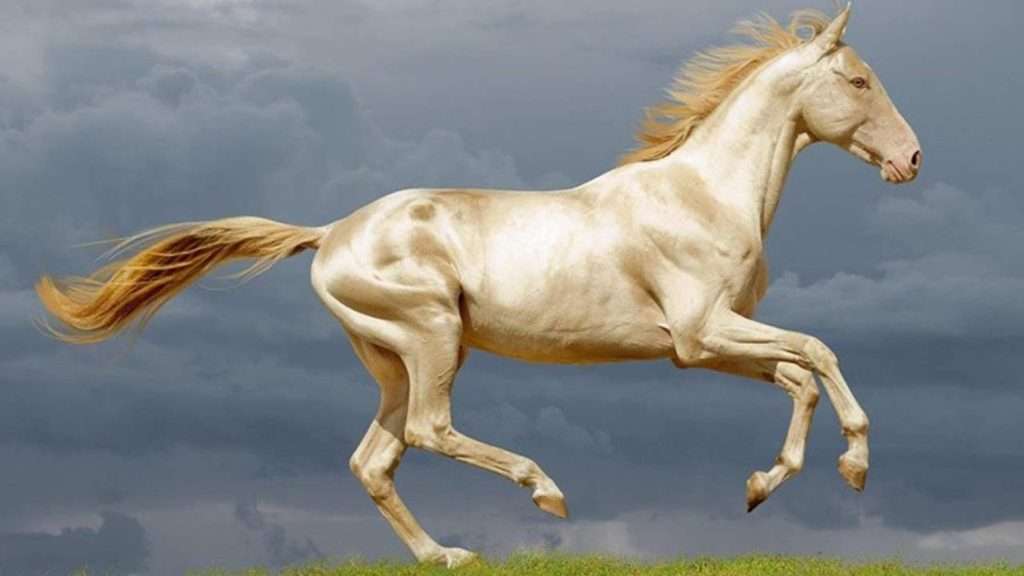The horse animal is a mammal and is considered one of the domestic animals that have been bred since ancient times to serve humans. The horse is known for its strength and speed and is used for a variety of purposes including riding, agriculture, racing, sports, and working in journeys and military shows. The horse is characterized by its strong and flexible body, long neck, long legs excellent for running and jumping, and a tail that can be used for balance and communication.
Below we review on TekeTrek Website more details about it, how it reproduces, its lifestyle, uses, and its status among humans.

Specifications and define of the Horse animal
The horse belongs to the equid family and the mammal class. It has unique specifications and appearance. What distinguishes the horse?
- Body: The horse has a strong, rectangular-shaped body, and its size ranges from small to large depending on the breed and lineage.
- Height: The height of the horse ranges from about 1.4 meters to 1.8 meters at the shoulder, and some larger breeds may exceed that.
- Color: The horse comes in a variety of colors including white, black, brown, gray, and other colors.
- Neck: The horse’s neck is long and strong, allowing it to carry its head proudly and control its movements easily.
- Head: The horse’s head is relatively small compared to the size of the body, with long ears, large eyes, and a large mouth that allows them to carry the bit and chew.
- Limbs: The horse has four long limbs that end with curved ring-shaped edges known as hooves, which are an important part of the horse’s structure and help it move and balance.
- Tail: The horse has a long, thick tail that can be used for balance and communication with other horses.
- Hair: The horse often has dense hair covering its body, and the color and texture of the hair vary depending on the breeds and origins.
- Eyes: The horse’s eyes are large and clear, and they have strong peripheral vision that helps them detect danger and move safely.

Reproduction in Horses
The horse animal is a mammalian animal that reproduces by birth, The process of reproduction in horses includes several stages and details, and here is a brief overview of the horse’s reproduction process:
- The horse usually reaches sexual maturity around the age of three, but this can vary depending on the individual and the breed.
- The appropriate female and male are selected for mating based on genetic, physical, and lineage characteristics.
- The female’s pregnancy period lasts between 11 and 12 months, and at the end of the pregnancy, the female usually gives birth to one offspring.
- The female takes care of the offspring and provides the necessary care, and the offspring is breastfed for a period ranging between 4 and 6 months.
- Growth: The offspring gradually develops and grows healthily, becoming fully self-reliant within several months.
Horse Nutrition
What do horses eat? In fact, The horse’s diet mainly consists of grasses and plants, which is a vegetarian diet. Among the common components in a horse’s diet:
- Grass: Fresh and dried grass forms the main food for horses and includes a wide range of species.
- Grains: Grains such as oats, barley, and corn can be added to the horse’s diet as a source of additional energy and protein.
- Legumes: Local beans are a rich source of protein, vitamins, and minerals, and can be added to the horse’s diet.
- Straw: Straw can be used as a source of fiber in the horse’s diet and sometimes horses consume straw not only as food but also to aid digestion.
- Essential Minerals: Horses also need to be provided with salt and essential minerals such as calcium, phosphorus, and magnesium as part of their diet.
A horse should be given a balanced diet containing a variety of components to ensure its health and physical activity.

What is the name of the animal horse?
- A mature male horse is called a stallion, and a female is called a mare. The stallion used for breeding is referred to as a stud. Young male horses are called colts and females are called fillies.
- Stallions were used for riding, while mares were kept for breeding purposes only, whereas geldings were used for work and as riding horses for ladies.
Horse Lifestyle
- Horses prefer to live in herds in their natural environment in the wild, where they stay together in small groups led by a male stallion and include females and foals.
- A herd may consist of about 20 members, and domestic horses may feel lonely if they do not have any companionship from other horses.
- Horses mostly sleep standing up, but they sometimes doze off lying down.
5 uses of horse and it benefits
- The horse animal has served people in various aspects of life in travel, war, and work, providing many goods.
- Before history, wild horses were hunted for food. Horses were hunted for their meat, and people still consume horse meat in Europe and Iceland, as well as in pet food.
- Research indicates that horses were domesticated about 6,000 years ago. Before the advent of mechanical vehicles, horses were widely used as draft animals and were one of the main means of transportation.
- They were also used in plowing fields, bringing in the harvest, transporting goods and passengers, tracking game and livestock.
- They carried warriors into battle and adventurers into unknown lands and were used for entertainment in the form of jousting, tournaments, carousels, and horse riding sports.
- Horse bones and cartilage are used in glue manufacturing.
- Tetanus antitoxin is extracted from the serum of horses previously vaccinated with tetanus toxoid.
- A number of goods are made from horse hides, such as luxury shoes and belts. The Cordovan leather made by the Moors in Cordoba, Spain, was originally made from horse hides.
- Fur coats are made from the elegant hair of fillies, and horsehair is used in upholstery, mattresses, and the stiff lining of coats and suits. High-quality white horsehair has been used in violin bows.
- Horse manure is used as a basis for mushroom cultivation and was used by the Scythians as fuel.
- Mare’s milk was drunk by the Mongols and Arabs.

What are 5 interesting facts about horses?
Some of the most exciting facts about horses:
- Horses can live for several years, with some reaching thirty years on the planet or longer.
- The horse’s digestive system moves in only one direction, from front to back only, which means it cannot vomit. Therefore, you should not accidentally feed your horse the wrong type of food because it will not be able to vomit.
- Horses breathe through their noses only, unlike humans, and because they use their noses only for breathing, blocked or swollen nasal passages pose a danger to your horse.
- Horses have excellent hearing and can rotate their ears in different directions to enable them to hear better.
- Horses communicate through facial expressions, not just through neighing. They use their facial expressions to show their emotions, especially with their eyes, ears, and noses.
- Horses are widely used in mental health therapy, based on the idea that the relationship between the patient and their horse helps build trust and improve health.
How to Measure Horses
- Horses are measured from the ground to the top of the withers, and the withers form the highest point on the back by the vertebrae between the shoulder blades.
- Traditionally, horses are measured in “hands,” with one horse hand being (10 cm).
- The Shire is considered one of the tallest breeds, which may reach a height of up to 193 cm, and the height of miniature horses may reach up to 51 cm.
Horse classification and Breeds
- Appaloosa, Belgian Draft, Holsteiner, and Quarter Horse are just examples of the 200 different horse breeds that live around the world today.
- These breeds look completely different, but they all belong to one species: Equus caballus.
- Later, people created different breeds by mating horses that have desirable traits, so the appearance of the breed is associated with what it is used for. When these traits are passed through several generations, a new breed is produced.
Horse classification by body
Horses come in 3 basic types according to their body structure:
- Ponies
Usually small in size and full in appearance, they were developed for use in specific environments, with the depth of their bodies equal to the length of their legs. In equestrian competitions, any horse shorter than 147 cm is considered a pony.
The weight of ponies’ ranges from 200 to 1500 pounds, which is 91 to 680 kg.
- Light Breeds
They were used for riding, racing, jumping, and herding, and herding. Their long, slender legs are designed for speed. Their long, flexible neck helps them maintain balance while running and maneuvering, and a well-defined withers allows for easy saddle fitting on light horses.
The weight of light breeds ranges from 800 to 1500 pounds, which is 363 to 680 kg.
- Heavy Breeds
Heavy breeds or draft horses are large, massive horses designed to pull plows and carts and carry heavy loads. They have relatively short, strong legs that give them better pulling power, as well as muscular short backs and strong hindquarters that help them pull large weights.
The weight of heavy breeds ranges from 1400 to 2700 pounds, which is 635 to 1225 kg.
Horse Care: Tips and Guidelines
There are several tips and guidelines that should be followed to ensure optimal horse care, protect the animal from diseases, and maintain its health. The most important of these include:
- Providing adequate and appropriate food such as hay, green pastures, grains, and nutritional supplements.
- Provide clean water in clean bowls and offer it regularly.
- Maintain general hygiene by cleaning the hooves and tail and washing the horse’s entire body.
- Exercising the horse regularly through walking or running to enhance its activity and maintain vitality.
- Monitoring the horse’s health and behavior, keeping an eye on its general condition, appetite, and water intake.
- Conducting regular veterinary checkups to detect any health issues early and treat them promptly.
- Providing routine vaccinations to protect the digestive system and prevent intestinal infections.
- Ensuring suitable shelter based on weather conditions—whether hot or cold—the housing must be comfortable and clean.
History of Horses in Warfare
We can trace the use of horses in warfare and their role as transportation and in combat battles back to:
- First used in war more than 5000 years ago. There is historical evidence of horse use in Eurasia around 4000 BC, with Sumerian war depictions dating back to 2500 BC.
- Throughout military history, horses were used extensively for transportation and played a significant role in supporting armies on the battlefield.
- Muslims relied heavily on horses during the conquests of North Africa, Europe, and Asia in the 7th and 8th centuries as part of the Islamic expansions.
Best Horse Breeds for Racing
There are many horse breeds worldwide, but the most prominent ones used in sporting events and festivals include:
- Thoroughbred Horses: Known for their unique traits that make them dominant in racing—they are fast, agile, strong, and beautifully shaped.
- Purebred Arabian Horse: One of the most important horses in Arab racing due to its exceptional endurance, speed, and agility, surpassing many other horse breeds.
Advanced Horse Training: Techniques and Methods
Some foundational techniques must be used for training horses, particularly for running and movement. These include:
- Preparing the horse by gently tying a small rope around its neck and body to help it get used to restraint.
- Fixing the halter behind the ears and around the head securely.
- Tightly tying a rope around the neck for half an hour, then gently removing it, repeating this twice a day.
- Place the saddle on his back for 2 hours daily.
- Inserting the bit in the horse’s mouth and attaching it to the saddle rope for three hours daily until the horse becomes accustomed to it.
- Leading the horse gently while walking, then progressing to short-distance rides to get the horse used to movement.
General Horse Health: Prevention and Treatment
To maintain a horse’s overall health, several preventative and treatment measures should be taken:
- Administering required vaccinations according to a regular schedule under a veterinarian’s supervision.
- Keeping the horse’s living space clean to prevent the spread of diseases and viruses.
- Providing a balanced and varied healthy diet.
- Offering fresh, clean drinking water regularly, as horses will not drink dirty or stagnant water.
- Cleaning, sanitizing, and drying all horse riding equipment before reusing it.
- Engaging the horse in physical activities to strengthen its muscles and boost fitness.
- Conducting regular veterinary checks to detect and prevent health issues.
- Protecting horses from contaminants such as spoiled food or fungus-infected soil.
- Performing fingertip massages on the horse’s body, especially the back and belly, to stimulate blood circulation and prevent internal muscle disorders.
Famous Horses of the World: Stories and Facts
Various horse breeds around the world have rich histories and unique characteristics. Some of the most famous include:
- The Arabian Horse: One of the oldest and most valuable breeds in the world. This elegant lineage has been preserved for centuries and holds great cultural significance, especially among Gulf tribes. Originally bred by Arab Bedouins in the desert, Arabian horses are known for their purity, beauty, elegance, and agility.
- The Marwari Horse (India): A noble breed with a strong physique used for long desert journeys. Known as the “battle hero,” it was the emblem of the Rajput rulers in India.
Comparison Between Wild and Domesticated Horses
Here are the key differences between wild and domesticated horses:
- Wild Horses:
- Typically live in grasslands and plains, especially near the Altai Mountains in Mongolia.
- Capable of surviving long periods without water, relying on plant moisture and grasses.
- Have sometimes been crossbred with domesticated horses.
- Natural predators include wolves and lions.
- Domesticated Horses:
- Domestication began 6,000 years ago in the steppe region north of the Black Sea—from Ukraine to Kazakhstan.
- DNA analysis from maternal lines shows significant genetic diversity among modern horses.
- Studies indicate that today’s horses are a blend of ancient lineages tracing back to the first mare that lived between 130,000 and 160,000 years ago.
Horses in Different Cultures
Horses carry powerful meanings and symbols of bravery, nobility, and speed across various cultures. Their significance includes:
- Horses are admired for their grace, nobility, expressive eyes, strength, leadership, endurance, and victory. Artists have depicted horses throughout history, including cave art in Lascaux, France, dating back 15,000 years.
- Horses are deeply rooted in both American and Arab cultures, with Arab tribes often considering them a symbol of identity and pride.
- Horses are essential in prestigious races and equestrian sports such as show jumping and polo. In the Gulf region, rare horse breeds are used in elite competitions for high-ranking prizes.
- Horses are widely praised in classical Arabic poetry—such as Al-Mutanabbi’s poems—and horse eyes are often used metaphorically to describe human beauty. It symbolize strength and victory in Arab wars and Islamic conquests.
FAQs about horses
- Is a horse an animal?
yes, horse is an animal.


In conclusion, it is worth mentioning that the impact of the horse animal is expressed in terms such as chivalry, which refers to honor, respect, good morals, and integrity.





